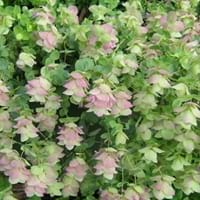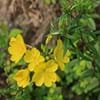Life Span
Perennial
Perennial
Origin
Northeastern United States, Mid-Atlantic United States, Southeastern United States, North-Central United States, Central United States, South-Central United States
Hybrid origin
Types
Apricot Delight, Copper canyon
Kent Beauty
Amethyst Falls
Barbara Tingey
Habitat
Roadsides, sand dunes, Waste areas
Grassland, Open scrub, Rocky areas
USDA Hardiness Zone
5-8
5-8
Sunset Zone
1a, 1b, 2a, 2b, 3a, 3b, 4, 5, 6, 7, 8, 9, 10, 11, 12, 13, 14, 15, 16, 17, 18, 19, 20, 21, 22, 23, 24
Not Available
Habit
Clump-Forming
Clump-Forming
Minimum Height
Not Available
Minimum Width
Not Available
Flower Color Modifier
Bicolor
Bicolor
Fruit Color
Tan
Not Available
Leaf Color in Spring
Green
Dark Green
Leaf Color in Summer
Green
Dark Green
Leaf Color in Fall
Green
Dark Green
Leaf Color in Winter
Light Green
Light Green
Plant Season
Summer
Summer, Fall
Sunlight
Full Sun, Partial Sun
Full Sun
Type of Soil
Loam, Sand
Loam
The pH of Soil
Acidic, Neutral, Alkaline
Neutral, Alkaline
Soil Drainage
Well drained
Well drained
Bloom Time
Early Summer, Summer, Late Summer
Late Summer, Early Fall
Tolerances
Variety of soil types
Drought
Where to Plant?
Container, Ground, Pot
Container, Ground, Pot
How to Plant?
Divison, Seedlings, Stem Planting
Seedlings
Plant Maintenance
Low
Medium
Watering Requirements
Average Water Needs, Do Not over Water, Never Over-water, Requires regular watering, Water more in summer
Allow soil to be completely dry in between waterings, Does not require lot of watering, Water twice a day in the initial period, Water when soil is dry
In Summer
Lots of watering
Lots of watering
In Spring
Moderate
Moderate
In Winter
Average Water
Average Water
Soil pH
Acidic, Neutral, Alkaline
Neutral, Alkaline
Soil Type
Loam, Sand
Loam
Soil Drainage Capacity
Well drained
Well drained
Sun Exposure
Full Sun, Partial Sun
Full Sun
Pruning
Remove damaged leaves, Remove dead branches, Remove dead leaves, Remove dead or diseased plant parts
Remove damaged leaves, Remove dead branches, Remove dead leaves
Fertilizers
All-Purpose Liquid Fertilizer, fertilize in growing season
All-Purpose Liquid Fertilizer
Pests and Diseases
Slugs, Snails
Red blotch
Plant Tolerance
Variety of soil types
Drought
Flower Petal Number
Single
Single
Fragrant Leaf
No
Not Available
Foliage Texture
Fine
Fine
Foliage Sheen
Matte
Matte
Attracts
Insects
Butterflies
Allergy
Abdominal pain, Constipation, Diarrhea, Skin irritation
Not Available
Aesthetic Uses
Beautification, Borders, Landscape Designing, Showy Purposes
Showy Purposes
Beauty Benefits
Good for skin, Making cosmetics, Stops hair loss
Not Available
Environmental Uses
Air purification, Food for insects, Versatility
Air purification
Medicinal Uses
Eczema
Bloating, Bronchitis, Cough, Cramps, Croup, Gastrointestinal disorders, Headache, Rheumatoid arthritis, Urinary tract problems
Part of Plant Used
Root
Leaves
Other Uses
Decoration Purposes, Medicinal oil, Showy Purposes, Used as Ornamental plant, Used for its medicinal properties
Employed in herbal medicine, Used As Food
Used As Indoor Plant
Yes
Yes
Used As Outdoor Plant
Yes
Yes
Garden Design
Edging, Feature Plant, Groundcover, Mixed Border
Container, Edging, Groundcover, Mixed Border
Botanical Name
OENOTHERA 'Cold Crick'
ORIGANUM 'Rose Dome'
Common Name
Suncups, sundrops
Ornamental Oregano
In Hindi
Evening Primrose
सजावटी अजवायन
In German
Evening Primrose
Ornamental Oregano
In French
onagre
ornement origan
In Spanish
onagra
Ornamentales orégano
In Greek
Νυχτολούλουδο
καλλωπιστικά Ρίγανη
In Portuguese
Evening Primrose
ornamental Oregano
In Polish
wiesiołka
ozdobne Oregano
In Latin
vespere Primrose
decentius Oregano
Phylum
Magnoliophyta
Not Available
Class
Magnoliopsida
Magnoliopsida
Order
Myrtales
Not Available
Family
Onagraceae
Lamiaceae
Clade
Angiosperms, Eudicots, Rosids
Angiosperms, Eudicots
Subfamily
Onagroideae
Pitcairnioideae
Number of Species
Not Available
Importance of Evening Primrose and Ornamental Oregano
Want to have the most appropriate plant for your garden? You might want to know the importance of Evening Primrose and Ornamental Oregano. Basically, these two plants vary in many aspects. Compare Evening Primrose and Ornamental Oregano as they differ in many characteristics such as their life, care, benefits, facts, etc. Every gardener must at least have the slightest clue about the plants he wants to plant in his garden. Compare their benefits, which differ in many ways like facts and uses. The medicinal use of Evening Primrose is Eczema whereas of Ornamental Oregano is Bloating, Bronchitis, Cough, Cramps, Croup, Gastrointestinal disorders, Headache, Rheumatoid arthritis and Urinary tract problems. Evening Primrose has beauty benefits as follows: Good for skin, Making cosmetics and Stops hair loss while Ornamental Oregano has beauty benefits as follows: Good for skin, Making cosmetics and Stops hair loss.
Compare Facts of Evening Primrose vs Ornamental Oregano
How to choose the best garden plant for your garden depending upon its facts? Here garden plant comparison will help you to solve this query. Compare the facts of Evening Primrose vs Ornamental Oregano and know which one to choose. As garden plants have benefits and other uses, allergy is also a major drawback of plants for some people. Allergic reactions of Evening Primrose are Abdominal pain, Constipation, Diarrhea and Skin irritation whereas of Ornamental Oregano have Not Available respectively. Having a fruit bearing plant in your garden can be a plus point of your garden. Evening Primrose has no showy fruits and Ornamental Oregano has no showy fruits. Also Evening Primrose is flowering and Ornamental Oregano is flowering. You can compare Evening Primrose and Ornamental Oregano facts and facts of other plants too.





